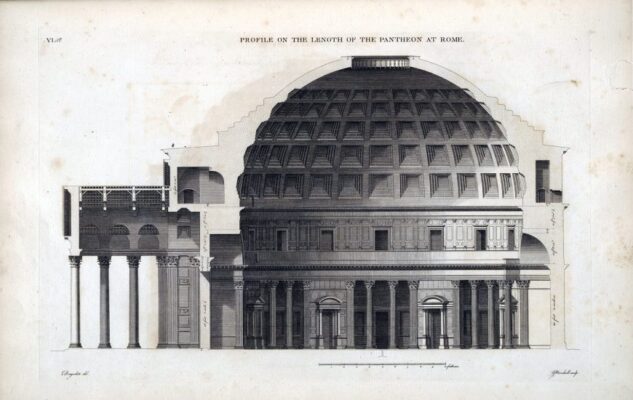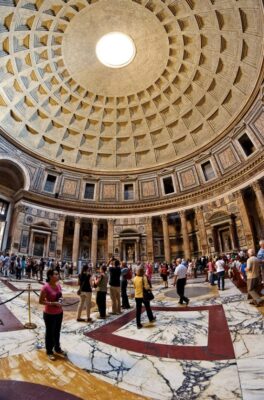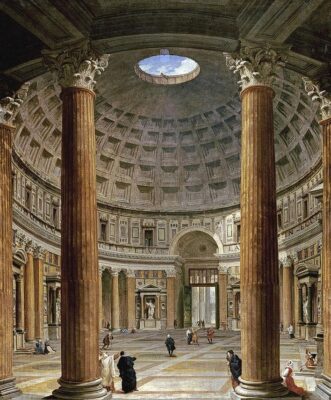The Pantheon of Rome stands as a testament to ancient ingenuity, boasting the world’s largest unreinforced concrete dome, a feat that has stood the test of time for over 1,900 years. This iconic structure continues to captivate visitors with its architectural brilliance and symbolic significance. Follow archeology.dulichvn.net to discover many hidden mysteries that have yet to be discovered.

The Architectural Masterpiece of the Pantheon
The Unmatched Dome of the Pantheon
The Pantheon’s dome remains one of the most remarkable feats of ancient engineering. With a diameter of 43.3 meters, it holds the distinction of being the largest unreinforced concrete dome in the world. The ingenious design of the dome incorporates coffered panels that not only reduce the structure’s overall weight but also enhance its visual appeal, creating a perfect balance of form and function.
The Oculus: A Gateway to the Sky
At the heart of the Pantheon’s dome lies the oculus—an 8.7-meter-wide circular opening that serves as both a striking feature and a vital source of light. The oculus allows sunlight to pour into the temple, creating a dramatic and ethereal effect within. This symbolic opening connects the earthly realm to the divine, embodying the Pantheon’s role as a link between the human and the celestial worlds.
Mastery of Roman Engineering
The construction of the Pantheon stands as a testament to Roman engineering genius. The Romans employed advanced techniques and materials, such as lightweight volcanic ash and pumice, to ensure the structural integrity of the dome while reducing its weight. This clever use of resources allowed the Pantheon to withstand the test of time, making it a monumental achievement in both design and engineering.

The Pantheon’s Connection to Rome’s Founding
April 21: A Day of Celestial Celebration
On April 21 each year, a unique celestial event takes place at the Pantheon, aligning with the anniversary of Rome’s founding. As the sun rises, its rays pass directly through the oculus, casting a beam of light that illuminates the Pantheon’s main entrance. This stunning natural phenomenon symbolizes Rome’s enduring legacy and its deep connection to the heavens.
Symbolism of the Sun’s Alignment
This annual event goes beyond a mere display of light—it embodies the unity between human achievement and the cosmos. The sun’s rays, perfectly aligned with the oculus, signify the celestial favor bestowed upon Rome and its people. It serves as a reminder of the ingenuity and vision that created the Pantheon, a structure that continues to honor Roman identity and culture.
A Celebration of Rome’s Timeless Legacy
Each year, Romans and visitors alike gather at the Pantheon to witness this breathtaking spectacle, celebrating not just the founding of Rome but also the city’s rich history and heritage. The event serves as a powerful reminder of the Pantheon’s central role in Roman architecture and culture, linking the past with the present and inspiring awe in all who experience it.

The Enduring Legacy of the Pantheon
A Temple Across Time
Originally constructed as a grand temple dedicated to all the gods of ancient Rome, the Pantheon has withstood the test of time, undergoing significant transformations throughout history. After the fall of the Roman Empire, the building was consecrated as a Christian church, which not only preserved it from destruction but also ensured its continued importance in religious and cultural life.
A Blueprint for Modern Architecture
The Pantheon’s innovative design and perfect proportions have inspired architects for centuries. Its harmonious blend of space, light, and form has influenced a wide range of structures, from Renaissance cathedrals to contemporary public buildings. The Pantheon’s architectural principles remain a cornerstone of design, offering timeless lessons in balance and grandeur.
A Must-See Cultural Monument
Today, the Pantheon stands as one of Rome’s most iconic and visited landmarks. Its architectural brilliance, combined with its deep historical and religious significance, makes it a must-see destination for anyone interested in history, art, and engineering. Visitors from around the world continue to marvel at its enduring beauty and its status as a symbol of Rome’s cultural heritage.
See more: The Location of Julius Caesars Assassination: the Fateful Ides of March
Conclusion
The Pantheon of Rome is more than just a building—it is a symbol of human achievement and a link to ancient history. From its unreinforced concrete dome to the annual celestial event on Rome’s founding day, the Pantheon continues to inspire awe and admiration. As one of the most iconic structures in the world, it stands as a timeless reminder of Rome’s enduring legacy.


CÁC TIN KHÁC
Mary Walton: The Forgotten Inventor Who Helped Clean Up America’s Cities
Tomb of Queen Nefertari in the Valley of the Queens, Egypt
Discover the Hypostyle Hall of the Temple of Hathor at Dendera
Venus de Losange: Unveiling the Mystery of a 20,000-Year-Old Paleolithic Icon